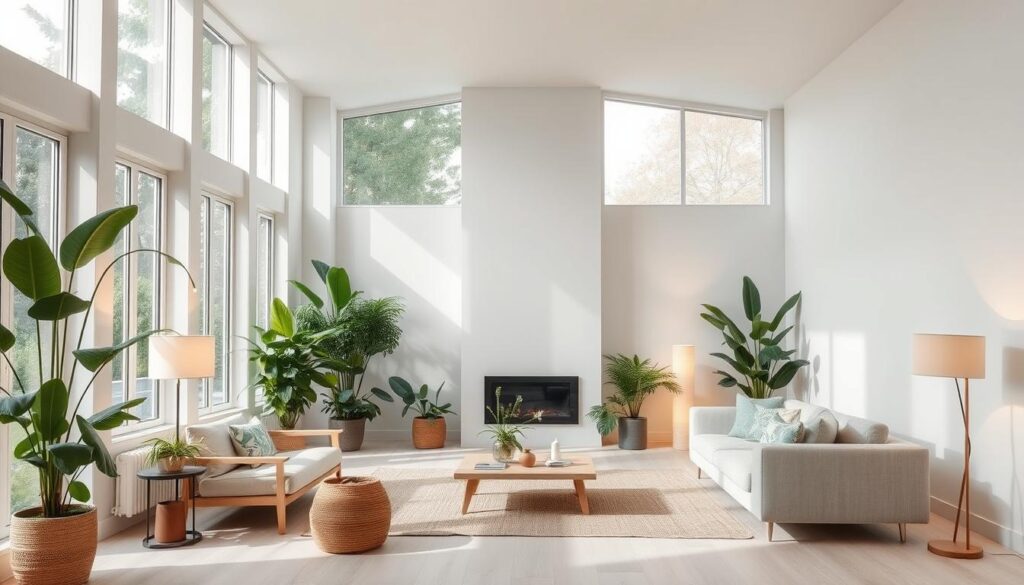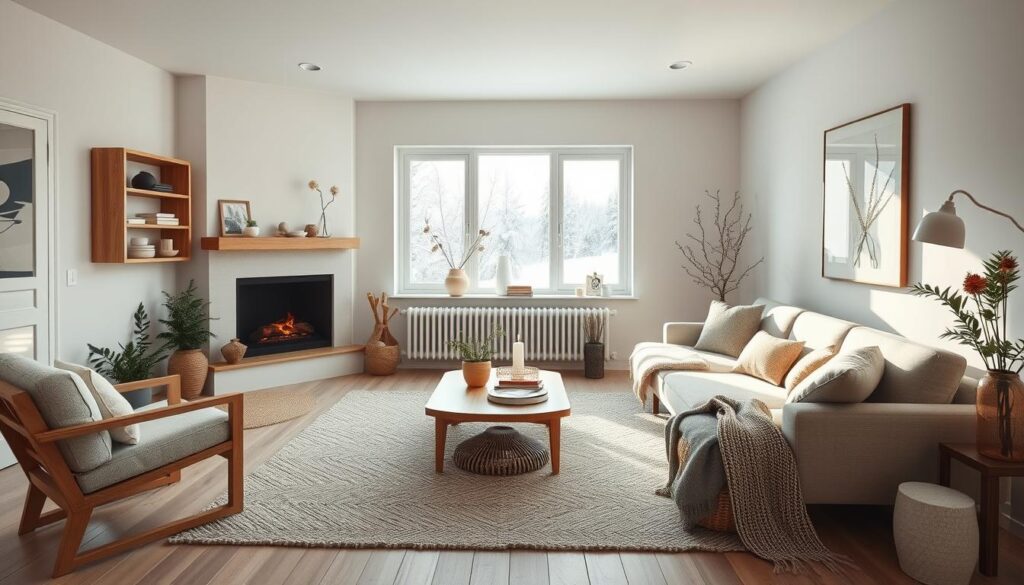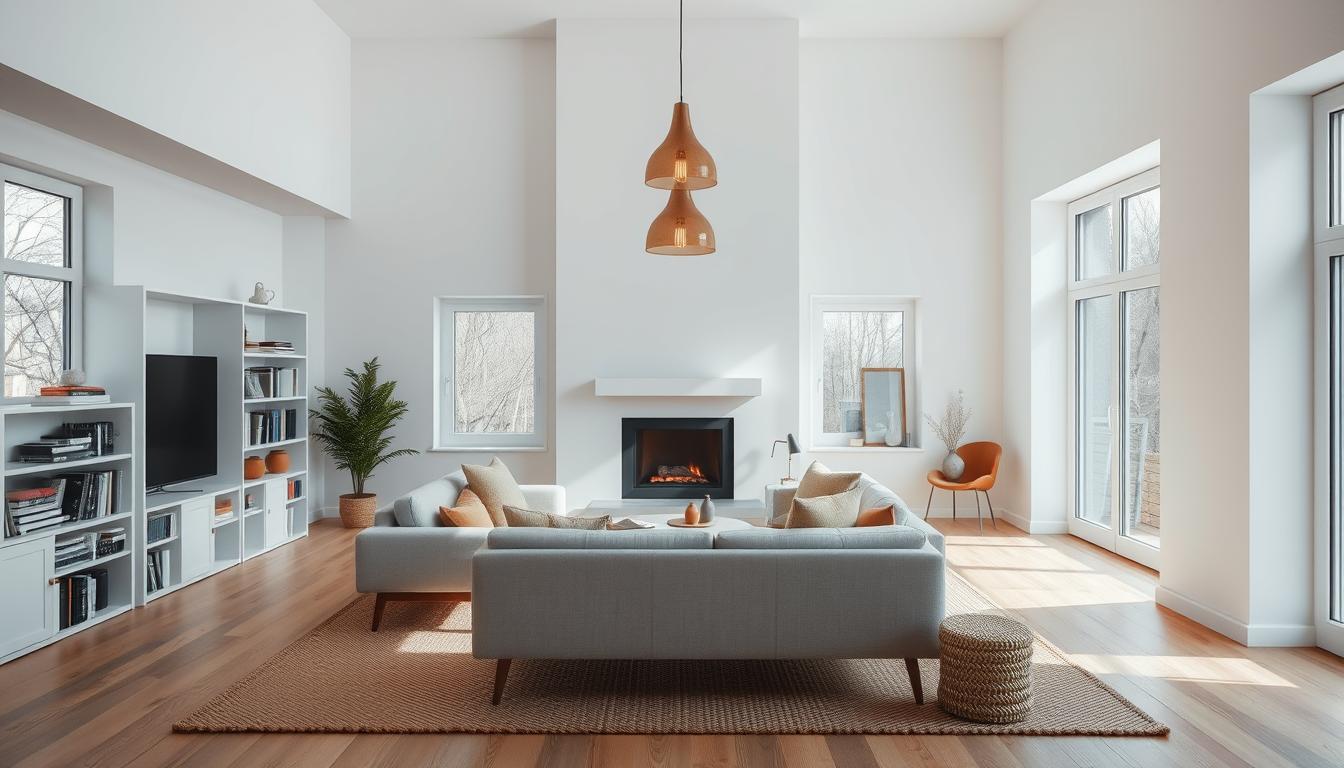Did you know Scandinavian interior design is super popular in America now? It started in the 20th century. This style is all about being simple and cozy, mixing function with beauty.
We dive into Nordic interior trends, looking at what makes them special. We’ll share how to bring this style into your minimalist Scandinavian design. Scandinavian design aims to make your home warm and welcoming, perfect for those who love simplicity and comfort.
Key Takeaways
- Scandinavian design emphasizes simplicity and functionality.
- It incorporates natural materials and neutral colors.
- Cozy textiles like sheepskin rugs and mohair throws are characteristic.
- Maximizing natural light is a key element.
- Quality craftsmanship is highly valued in Scandinavian design.
Understanding Scandinavian Design Aesthetics
Scandinavian design values simplicity, comfort, and function. It’s more than looks; it shows the Nordic lifestyle. This includes simplicity, practicality, and a love for nature.
Key Characteristics of Scandinavian Design
Scandinavian design has unique traits that make it special. These include:
- Clean Lines and Simple Shapes: It prefers clean lines and simple shapes. This avoids clutter and extra decoration.
- Limited Color Palette: It uses a few colors like whites, grays, and beiges. This creates a calm look.
- Emphasis on Functionality: Each piece is chosen for its use and beauty.
The Role of Minimalism in Scandinavian Interiors
Minimalism is key in Scandinavian interiors. It brings calm and serenity. By focusing on the essential, spaces feel open and clear.
Minimalist Scandinavian design isn’t just about less stuff. It’s about making a space that’s good for your well-being. This is done by picking a few high-quality, useful items that look great together.
Importance of Functionality and Comfort
Functionality and comfort are top priorities in Scandinavian design. The Scandinavian furniture style is known for being both comfy and useful. It often uses ergonomic design and soft materials.
Some important points about functionality and comfort are:
- Ergonomic Furniture: Chairs and sofas are made to be comfy and supportive. This shows Scandinavian love for comfort.
- Cozy Textiles: Soft materials like throws, rugs, and pillows add warmth and texture.
- Practical Storage: Creative storage keeps the space clean and tidy.
By understanding and using these elements, you can make a Scandinavian-inspired space. It will be both beautiful and useful.
The Color Palette of Scandinavian Homes
In Scandinavian design, colors are key to a home’s look, often sticking to neutral shades. This makes spaces calm and versatile for adding textures and patterns.
Popular Colors for Walls and Accessories
Scandinavian homes favor soft, muted colors. Whites, creams, and grays are common for walls, furniture, and decor. These colors make rooms feel bigger and brighter, perfect for the long, dark winters.
These neutral tones also welcome natural materials like wood and wool. They add warmth and depth to any room.
How to Use Neutrals Effectively
To make neutrals work in a Scandinavian home, mix different shades and textures. For example, smooth and rough textures together create interest. Layering neutral tones makes a space cozy and inviting.
Neutrals also let artwork and decor stand out. They become the room’s highlights.
Incorporating Bold Accents
Even with a focus on neutrals, Scandinavian homes can have bold touches. Textiles, artwork, and accessories in bright colors or patterns add personality.
It’s important to balance bold accents. One standout piece is enough to add flair without being too much. This way, you can express yourself while keeping the space calm.
Essential Furniture Styles for Scandinavian Design
Scandinavian interior design is all about simplicity. It uses clean lines and natural textures. This style makes spaces calm, functional, and comfortable.
Iconic Scandinavian Furniture Brands
Many famous brands are key to Scandinavian design. IKEA and Muuto are leaders in this field. They focus on natural materials and create furniture that looks good and works well.
- Minimalist Designs: Known for their simplicity and lack of extra details.
- Natural Materials: Wood, leather, and wool are favorites.
- Functionality: Each piece is made to be useful, not just pretty.
Choosing the Right Sofa and Chairs
When picking out a sofa and chairs, go for natural materials and comfort. Choose sofas and chairs with solid wood or leather upholstery. These add warmth and fit the Scandinavian style.
- Look for simple designs.
- Make sure the furniture fits your room well.
- Choose materials that last and are easy to care for.
The Importance of Natural Materials
Natural materials are vital in Scandinavian design. They make spaces feel warm and welcoming. Wood, like oak and pine, is a big part of this. Wool and linen are also used for their texture and warmth.
Using these materials helps create a cozy yet stylish space. It follows the Scandinavian design principles perfectly.
Lighting Choices in Scandinavian Interiors
Lighting is key in Scandinavian design, shaped by harsh winters and a love for natural light. In these homes, lighting does more than just light up the space. It adds to the look and feel of the room.
Exploring Natural Light and Its Impact
Scandinavians love natural light, which is scarce in winter. Homes often have big windows and skylights to let in as much light as possible. This not only brightens the room but also brings the outdoors in.
To get a similar feel at home, make sure windows are clear and use mirrors to spread light into shadowy spots.
Fixtures That Complement the Aesthetic
Scandinavian design likes simple, minimal lighting fixtures. These fixtures are designed to be both stylish and practical, fitting well with the home’s look.
- Choose fixtures with clean lines and simple shapes.
- Opt for materials that are natural or have a natural finish, such as wood or metal.
- Consider the scale of the fixture in relation to the room and furniture.
Tips for Layering Your Lighting
Layering lighting is a big part of Scandinavian design. It means using different lights to make a cozy and inviting space.
| Layer | Purpose | Examples |
|---|---|---|
| Ambient | General illumination | Ceiling lights, natural light |
| Task | Focused lighting for tasks | Desk lamps, reading lights |
| Accent | Highlighting specific features | Spotlights, LED strips |
By layering our lighting, we can make a space that’s both versatile and welcoming, meeting all our needs.
Textiles and Fabrics in Scandinavian Homes
In Scandinavian home design, textiles are key for warmth and coziness. The right fabrics can make a space feel welcoming and comfy.
Cozy Textiles for Comfort
Choosing the right textiles is crucial for coziness. Opt for wool and cotton for throw blankets, rugs, and pillows. These materials warm up your space and add a touchable feel.
The Role of Patterns and Textures
Patterns and textures bring life to your Scandinavian home. Mixing them creates a rich, layered look. Try pairing a velvet sofa with a chunky knit throw for contrast.
Layering Rugs for Warmth and Style
Layering rugs adds warmth and style to your space. Start with a neutral base rug and add a smaller, patterned rug on top. This adds interest and defines areas in open-plan spaces.
To see how textiles enhance Scandinavian design, check out this table:
| Textile | Material | Benefits |
|---|---|---|
| Throw Blankets | Wool, Cotton | Warmth, Coziness |
| Rugs | Wool, Jute | Texture, Warmth |
| Pillows | Linen, Cotton | Comfort, Style |
Using these textiles and techniques, you can create a Scandinavian home that’s both stylish and inviting.
Incorporating Nature Into Your Space
Biophilic design is a big part of Nordic interior trends. It aims to blend indoor and outdoor spaces smoothly. This approach believes that being close to nature boosts our well-being.

Benefits of Biophilic Design
Adding nature to our homes brings many benefits. Biophilic design can improve air quality, lower stress, and increase productivity. “Bringing the outdoors in makes our homes more peaceful and calming,” says a top interior designer.
Best Indoor Plants for Scandinavian Decor
Choosing the right indoor plants is key for Scandinavian decor. It focuses on simplicity and natural beauty. Plants like succulents and air plants are great because they’re easy to care for and add greenery.
- Snake Plant: Known for its air-purifying properties
- Pothos: Easy to care for and versatile
- ZZ Plant: Low maintenance and stylish
Utilizing Natural Light and Views
Using natural light and outdoor views is vital in biophilic design. Big windows and skylights let in lots of light. This makes our homes brighter and more welcoming.
“The way we interact with our environment has a significant impact on our mood and productivity. By embracing natural light and views, we can create a more inspiring living space.”
By adding these elements to our Scandinavian homes, we make them look better and feel more comfortable. We also make our homes more sustainable.
Creating a Functional Layout
In Scandinavian design, a functional layout is key. It’s not just about looks; it’s about making a space comfortable and inviting. A well-designed layout meets our daily needs.
Open Floor Plans vs. Defined Spaces
Choosing between an open floor plan or defined spaces is a big decision. Open floor plans make a space feel bigger and more open. They’re perfect for modern Scandinavian interiors that love simplicity.
Defined spaces, on the other hand, offer privacy and separate areas for different activities. Think about your lifestyle and what you prefer. An open floor plan is great for entertaining. But, if you work from home, defined spaces might be better for focus.
Tips for Effective Furniture Arrangement
Arranging furniture well is crucial for a functional layout. Here are some tips:
- Think about the flow of traffic in your home. Arrange furniture to make movement easy.
- Choose multi-functional furniture, like storage ottomans, to keep your design minimalist.
- Set up furniture to create cozy conversation areas. This makes your space more comfortable.
The Importance of Flow in Design
The flow of a space greatly affects its functionality. A good flow makes moving through the space smooth and logical. Think about the pathways people will take in your home and arrange furniture to guide them.
| Design Element | Impact on Flow | Scandinavian Design Tip |
|---|---|---|
| Furniture Placement | Can either enhance or hinder the flow, depending on arrangement. | Keep pathways clear and use furniture to guide the flow. |
| Room Dividers | Can define spaces within an open floor plan. | Use minimalist dividers, such as plants or screens, to maintain the Scandinavian aesthetic. |
| Color Scheme | Can influence the perceived flow by creating a sense of continuity or separation. | Use a cohesive color scheme to enhance the sense of flow and harmony. |
By considering these elements and tips, we can make a functional layout that follows Scandinavian design. It blends minimalist Scandinavian design with modern interiors. This creates a space that is both beautiful and functional.
Scandinavian Decor Elements We Love
Adding Scandinavian decor to your home can make it look better and feel cozier. It’s all about keeping things simple, elegant, and useful. This style is loved by many around the world.

Integrating Art and Personal Touches
Art and personal touches are key in Scandinavian decor. You can hang a big piece of art or show off personal items like old collectibles or family photos. This makes your space more interesting and personal.
Choose art that fits the Nordic style, like nature prints or abstract art with simple lines. Adding textiles with special patterns or colors can also make your space richer.
The Use of Mirrors and Reflective Surfaces
Mirrors and shiny surfaces are important in Scandinavian decor. They make rooms look bigger and add elegance. Try a big mirror over a sofa or a mirrored console table.
Mirrors also make rooms brighter and more welcoming. Choose frames that are simple and don’t have too much decoration to keep the Scandinavian look.
Incorporating Vintage Finds
Vintage items can make your Scandinavian-inspired space unique. Look for special pieces at thrift stores, antique shops, or online. You can also reupholster old furniture to make it look new again.
| Vintage Item | Modern Twist | Result |
|---|---|---|
| Vintage Armchair | Reupholster with modern fabric | Unique, stylish seating |
| Antique Side Table | Add a glass top | Elegant, functional surface |
| Vintage Rug | Layer with a modern rug | Cozy, visually interesting floor |
Eco-Friendly Choices in Scandinavian Design
Scandinavian design focuses on being green and sustainable. It’s great for those wanting an eco-friendly home. This style is not just about looks but also about living healthily and sustainably.
Sustainable Materials to Consider
Scandinavian design uses materials that are good for the planet. Reclaimed wood is a favorite for its look and for saving trees. Bamboo is also popular because it grows fast and lasts long. We should choose materials that are local to cut down on carbon emissions from shipping.
Here are some green materials and why they’re good:
| Material | Benefits | Common Uses |
|---|---|---|
| Reclaimed Wood | Reduces waste, unique aesthetic | Furniture, flooring |
| Bamboo | Fast-growing, durable | Furniture, decorative items |
| Recycled Metal | Conserves resources, reduces landfill waste | Lighting fixtures, decorative accents |
Energy-Efficient Solutions for Homes
Scandinavian design also means using less energy. Using LED lighting is a big help because it uses less power than old lights. Letting in more natural light also cuts down on the need for artificial light. This saves energy and makes our homes look better.
Here are some ways to use less energy:
- Get energy-saving appliances
- Make your home better insulated
- Put in solar panels to make your own power
Waste Reduction Tips for Interior Design
Reducing waste is key to eco-friendly design. Choose furniture and decor that’s made from sustainable or recycled stuff. Repurposing old items is another smart move. It gives them a new life and cuts down on waste.
To waste less, try these tips:
- Give away or sell things you don’t need
- Choose furniture that does more than one thing
- Think before you buy to avoid impulse purchases
By making these eco-friendly choices, we help the planet and make our homes beautiful and responsible.
Bringing It All Together: Final Tips
To make a beautiful Scandinavian-inspired home, we need balance and harmony. We should mix minimalist Scandinavian design with personal touches that show our style.
Maintaining Balance
Getting balance in Nordic interior trends means thinking about furniture, lighting, and textiles. We should pick a few standout pieces and pair them with neutral items. This keeps the space from feeling too busy.
Personalizing Your Space
Scandinavian home design is about more than just looks. It’s also about making the space our own. Adding unique touches like artwork or vintage items gives our home character.
Overcoming Design Challenges
Minimalist Scandinavian design can be simple. But we shouldn’t be scared to try new things. Experimenting helps us find the perfect balance for our home.
By following these tips, we can make a Scandinavian-inspired home that’s both beautiful and functional. Our space will show our personal style while following the timeless principles of Nordic interior trends.



